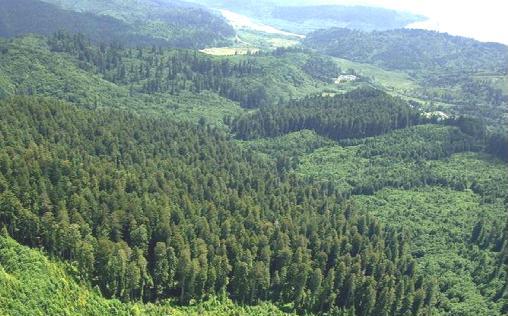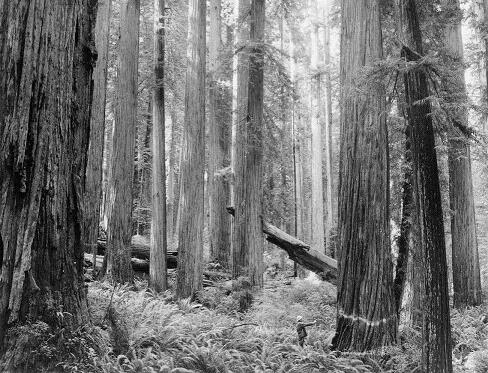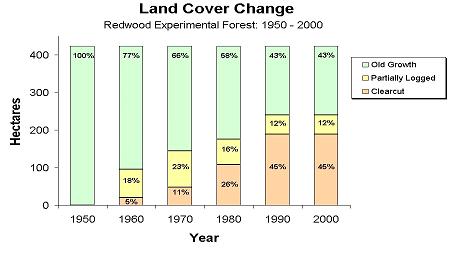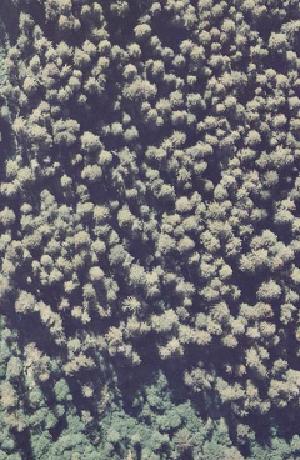|
Redwood Experimental Forest
Over half a century ago, a Redwood Experimental Forest was established near the town of Klamath, California to improve coast redwood forest management (Adams et al. 2003).
At the time, the reason for its formation was to improve logging practices and to find ways to ensure that the coast redwood forest would regenerate. Prior to that time, logging practices of the region left much to be desired.
|
 |
Prior to establishment of the Forest, coast redwood forests of the region were logged with little concern for long term forest recovery. Forest Service researchers were concerned that forest recovery was limited by soil erosion, fire and less than optimal silvicultural practices. In many stands, fires set to reduce logging debris killed regeneration and wildfires reduced the dominance of redwood by favoring competing conifers and shrubs. Researchers were particularly interested in applying partial harvesting techniques as they had the potential to reduce many of the undesired effects of clear cut logging.
Beginning in 1958, three basic silvicultural treatments were performed at the Forest--small patch clearcuts, selection logging and 2- and 3-stage shelterwood cuts. The selection cuts included only partial tree harvest and the shelterwood cuts involved removing trees over a period of years so that regeneration in openings could occur. Early findings were that partially logged stands and old growth patch edges were highly vulnerable to blowdown, due to the infamous 1962 Columbus Day storm, and subsequent harvesting often damaged regeneration. To learn more about the early history of the Forest see Boe (1983)

The paradigm that was at the heart of research at the Redwood Experimental Forest during these early decades was abruptly shaken with the exchange of nearly all of the US Forest Service's Redwood Ranger District land with a private timber company so that private lands could be acquired to create Redwood National Park. As old growth forests disappeared on private lands, the need for research on how to best convert old growth to sustainable second growth became irrelevant. While this silvicultural unit within the Pacific Southwest Research Station continued through the early 1980s, researchers looked to private lands and the Jackson State Forest's Caspar Creek experimental watershed. When the silvicultural unit was finally dissolved, public sentiment had changed as well. Society's emphasis on conservation and wildlife protection was mirrored with a new line of research at the Forest that continues to this day.

In recent decades, the partially logged stands of the Forest have been studied by a Humboldt State Master's student (Allgood 1996). Changes in understory vegetation have been the subject of a second thesis conducted in the Experimental Forest (Aviña 1997).
As part of the initial research program within the Redwood Experimental Forest, some old growth redwood had been kept as a long term control. In 1976, a portion of this old growth was formally set aside as the Yurok Research Natural Area (RNA). This RNA defines the wet coast redwood forest type within the Research Natural Area network.
The RNA consists of about 66 hectares (150 acres) including Coast Redwood Forest, a dryer Douglas Fir-Redwood Forest and a riparian Bigleaf Maple-Sitka Spruce forest (Taylor 1982). The Forest was also the site of an important old growth mapping project in the late 1970s by Stephen Veirs.
Wildlife research began in the Forest with the original experimental logging. In the 1950s, Humboldt State University students documented changes in small mammals immediately after logging because they were thought to consume the seeds needed for stand regeneration. The most intensive and integrative wildlife research to have ever been conducted in a coast redwood forest occurred here during the early 1990s.
|
 |
Coordinated censuses were taken of mammals, birds and herpetofauna as part of an old growth assessment project across the Pacific Northwest. Wildlife surveys were conducted in old growth and logged areas to monitor species response to logging as part of a long-term monitoring strategy and to understand how fragmentation affects biodiversity.
The forest harbors at least two species listed under the Endangered Species Act—the Marbled Murrelet (Brachyramphus marmoratus) and the Northern Spotted Owl (Strix occidentalis caurina). The Redwood Experimental Forest is one of three old-growth forests in northern California with long-term monitoring of Murrelet breeding season activity with adjacent offshore population monitoring, beginning in 1989 (Miller and Ralph 1995; Ralph 1995; Ralph et al. 1991).
Early on during this monitoring program, it was discovered that the Forest had the highest number of Murrelet detections per hectare of available habitat of sites examined in California. Given the regional fragmentation of the coast redwood old growth forest, the Experimental Forest will continue to provide important habitat for this species along with that portion of land in Redwood State and National Parks that were also unlogged.
The Experimental Forest has been the location of important redwood canopy research. The wandering salamander was first shown to be a canopy species there (Welsh and Wilson 1995). Such early discoveries led a new generation of forest researchers to look upward where they have since documented an entire ecosystem that had formerly been under-appreciated (Spickler et al. 2006).
The biomass of coast redwood forest is as high as any forest type on Earth due to the size of the trees. Forest Service and Humboldt State researchers have long used the Experimental Forest's old growth to understand how downed wood accumulates and influences forest dynamics. Data were collected by Bruce Bingham as part of an old growth characterization project (Bingham and Sawyer 1991), downed wood and vegetation dynamics were the focus of a Master's thesis (Porter and Sawyer, 2007) and a recent Humboldt State Master's student in forestry, Brad Graham, has described fuels in the Experimental Forest's old growth in detail.
______________
Steve Norman
|
|

